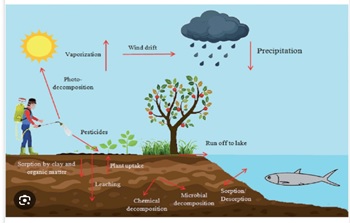Research on the Impact of River Pollution on Water Quality
DOI:
https://doi.org/10.54741/ssjar.3.4.3Keywords:
pesticides, chemical, water, pollution, human heathAbstract
Pesticides are a category of chemicals used worldwide as herbicides, insecticides, fungicides, rodenticides, molluscicides, nematicides, and plant growth regulators to control weeds, pests, and diseases in crops as well as for human and animal health. When pesticides are used, crop and food yields increase, and the spread of diseases by vectors is significantly reduced. They have, however, been used in an uncontrolled and indiscriminate manner, which has raised severe concerns for the environment in general as well as the health of people, birds, and other animals in particular. Despite widespread use bans, some of the least biodegradable and ecologically persistent pesticides, such as organochlorines, are nevertheless being used more often. Pesticides are extremely harmful to biological systems because of their fast lipid solubility and bioaccumulation in creatures other than their intended targets. Pesticides may have a variety of negative impacts, even at low concentrations, which may be seen in biochemical, molecular, or behavioural ways. Pesticide and residue water pollution is influenced by a number of factors, including drainage, rainfall, microbiological activity, soil temperature, treatment surface, application rate, solubility, mobility, and pesticide half-lives. The majority of pesticides used in India today, such as DDT and HCH, are organochlorine insecticides. There have been reports of the presence of pesticides in fresh water systems and samples of bottled mineral water from Delhi, Bhopal, and other cities, as well as some rural areas. Pesticide pollution's negative impacts on India's drinking water and riverine systems have been discussed in this review.
Downloads
References
Sharma, A.K., Malik. D.S. & Bargali, H. (2018). Food and feeding habits of schizothorox richordsonii inhibiting bhagirathi river tehri garhwal India. International Journal of Recent Scientific Research, 9(4), 25562-25565.
World Health Organization, (1993). Guidelines for drinking water quality. (2nd ed.). Geneva.
Risks & Remediation. Agro environ media. Haridwar, India, 1,111-128.
B. Goldar, & N. Banerjee. (2004). Impact of informal regulation of pollution on water quality in rivers in India. Journal of Environmental Management, 73(2), 117-130.
Abdullah, A., Mehana, E.E., & Meki, A. (2008). Evaluation of lead and cadmium levels in freshwater fish farms at qassim region, KSA. Journal of Agricultural and Veterinary Sciences, 1(2), 59-69.
Gupta, D. K. Rai, R. S. Pandey, & B. Sharma. (2009). “Analysis of some heavy metals in riverine water, sediments and fish from river ganges at Allahabad. Environmental Monitoring and Assessment, 157,449-458.
Singhania, & Neha. (2011). Pollution in river Ganga. Indian Institute of Technology Kanpur.
Das, & Subhajyoti. (2011). Cleaning of the ganga. Journal Geological Society of India, 78, 124-130.
Malik, D.S., Sharma, A.K., & Bargali, H. (2018). Status of phytoplankton diversity in relation to water quality of bhagirathi riverine system in garhwal himalaya. International Journal of Advanced Science and Research, 3(1), 30-37.
J. Jeyaratnam. (1985). Health problems of pesticide usage in the third world. British Medical Journal, 42, 505-506.

Downloads
Published
How to Cite
Issue
Section
ARK
License
Copyright (c) 2023 Dr. Rajeev Verma, Sanjeev Kumar

This work is licensed under a Creative Commons Attribution 4.0 International License.
Research Articles in 'Social Science Journal for Advanced Research' are Open Access articles published under the Creative Commons CC BY License Creative Commons Attribution 4.0 International License http://creativecommons.org/licenses/by/4.0/. This license allows you to share – copy and redistribute the material in any medium or format. Adapt – remix, transform, and build upon the material for any purpose, even commercially.










